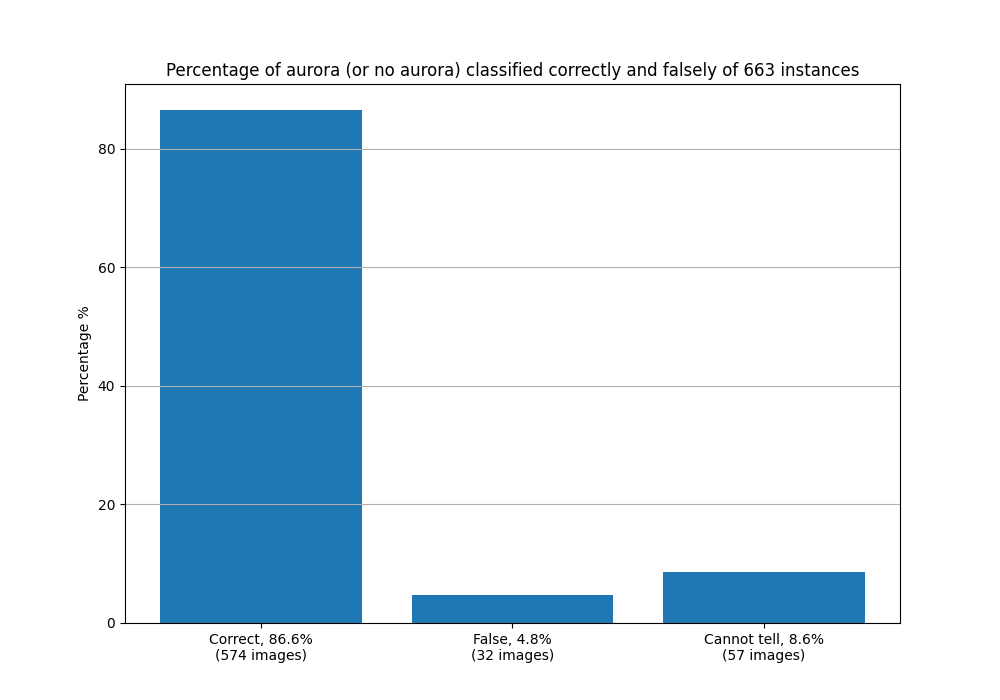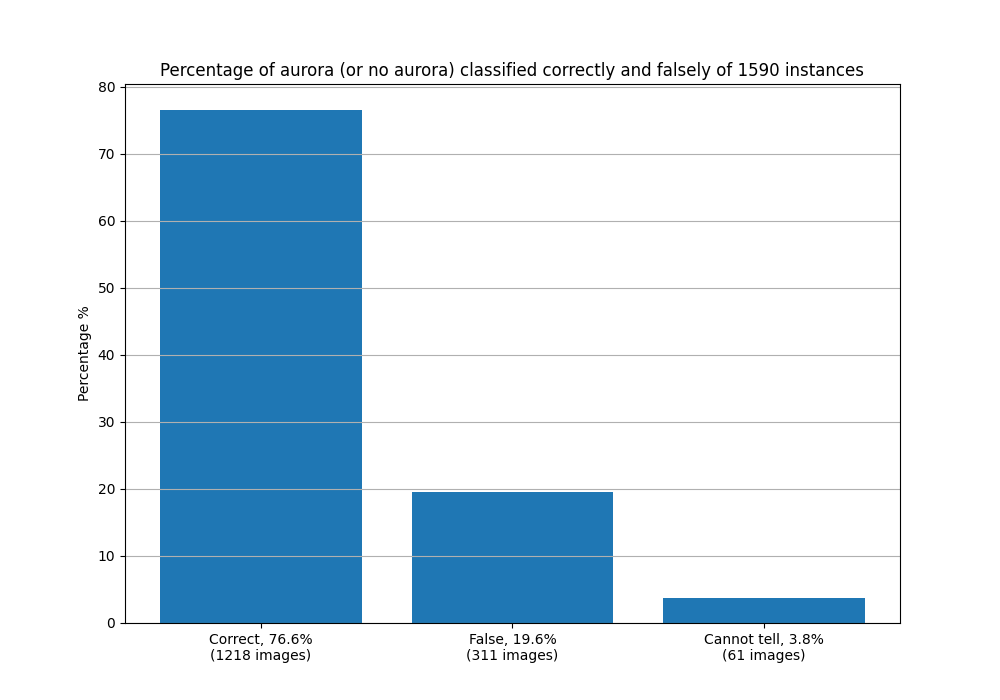Help
Introduction
Yamauchi and Brändström (2022) present an advanced way for automatic recognition of auroras from All-Sky Camera (ASC) images. The method utilizes both the Red-Green-Blue (RGB) and Hue-Saturation-Luminosity (HSL) codes of the color ASC images. The method is able to categorize pixels in the ASC image to classes like “visible diffuse”, “green arc”, or “strong aurora”. The algorithm categorizing ASC images in this product has been developed at the Finnish Meteorological Institute and it utilizes a simplified version of the method by Yamauchi and Brändström (2022). The goal has been to develop a robust and easily adoptable method that works on a tolerable confidence level also in non-optimal conditions (e.g. when the ASC dome has some snow or frost on it). The method categorizes ASC images into two bins: aurora or no_aurora. Thresholds used in the categorization has been tailored for the images of the camera operated by FMI at the Kevo station in Finnish Lapland. The approach analyses the images pixel by pixel. If a group of pixels satifies the properties of aurora, the image gets the label “aurora”. Otherwise, the image is categorized as “no_aurora”.
The categorization routine uses the HSL values of the image pixels. The values give the basis of binning according to the rules given in Table 1 below. The image is converted to a binary image using the HSL limits, with each pixel categorized as either “aurora” or “no-aurora”. Then, a top hat filter (van der Walt et al., 2014) is applied to filter out small features of auroral pixels. We have recognized that frost and/or snow on the dome can in some cases cause small-scale structures which the HSL-based method considers as auroras. With the top hat filter such structures are omitted. If any of the remaining connected features marked as aurora have an area larger than 100 pixels the image is categorized as “aurora”. The structure element used in the top hat filter is an octagon with side length of five pixels.
| Category | H | S | L |
|---|---|---|---|
| Green aurora | 0.19 < H < 0.52 | 0.06 < S < 1.0 | 0.05 < L < 0.94 |

Stéfan van der Walt, Johannes L. Schönberger, Juan Nunez-Iglesias, François Boulogne, Joshua D. Warner, Neil Yager, Emmanuelle Gouillart, Tony Yu and the scikit-image contributors. scikit-image: Image processing in Python. PeerJ 2:e453 (2014)
Yamauchi M. and U. Brändström, Auroral alert version 1.0: Two-step automatic detection of sudden auroral intensification from all-sky jpeg images, https://doi.org/10.5194/egusphere-2022-331.
Technical information
The Kevo camera belongs to the network of Boreal Auroral Camera Constellation (BACC) (Sigernes et al., 2021). BACC aims to store all the data generated by the camera constellation and to provide visual displays for the public in Near-Real-Time (NRT). The main raw data from each camera station is digital movies in the Audio Video Interleave (AVI) format. For the “aurora”/”no_aurora” categorization images from the movies are extracted with 1 min resolution. BACC cameras are equipped with a back illuminated Complementary Metal-Oxide-Semiconductor (CMOS) sensors and front optics with a fish-eye lenses. The CMOS sensors capture all the main visual wavelengths of auroras with the peak quantum efficiency (78%) at 500 nm.
Sigernes, F., Syrjäsuo M., Lybekk B., Trondsen E., Clausen L., Kellinsalmi M., Mattanen J., Kauristie K., Hall C., and M. G. Johnsen, The Boreal Aurora Camera Constellation (BACC) – Status 2021, 2021
Limitations and caveats of the product.
Above-described method has been validated with a set of ~2250 Kevo ASC images collected from different imaging situations: Auroras and no-auroras on clear sky, those on partly or totally cloudy sky, and with or without the Moon. The validation exercise, where the method output was compared by categorization by a human eye, has revealed that the routine has a slightly better performance in the category of “aurora” than in the category of “no-aurora”. Like Figures 2 and 3 below show, “aurora” categorization has been correct in 87% of the validated images, while “no-aurora” categorization has been correct in 77% of the images. In the latter case the routine has trouble particularly when auroras are dim and have other than green colors. In the validation of “aurora” category images where one can assume auroras appearing behind clouds have been considered as “aurora”, although such cases are not as interesting for touristic and scientific purposes as observations on a clear sky.


Use and functionality of the product
This product shows NRT color images from an ASC operated at the Kevo station (geographic latitude 69.8°; geographic longitude 27.0°; magnetic latitude ~ 66°) in Northern Finland. The images are automatically categorized into two bins: images with or without auroras. This web-site provides also three links for downloading recent results by the categorization method: Two of the links provide access to zip-packages with ASC images of “aurora” and “no_aurora” categories and the third link provides a Common-Separated-Values (CSV) file showing the categorization results from the last 30 days.
The top menu navigation bar allows to browse through the products as follows:
- Latest
- Switch to page showing the latest data.
- Archive
- Images from the last 48 hours and analysis results from the last 30 days can be downloaded from the archive page.
- Alert Subscription
- The link is disabled as the service is not provided for this product.
- Help
- Provides more details on the data product, its properties and constraints, the providing Expert Group as well as this general help on navigation. Note that this product does not provide any option for API Access.